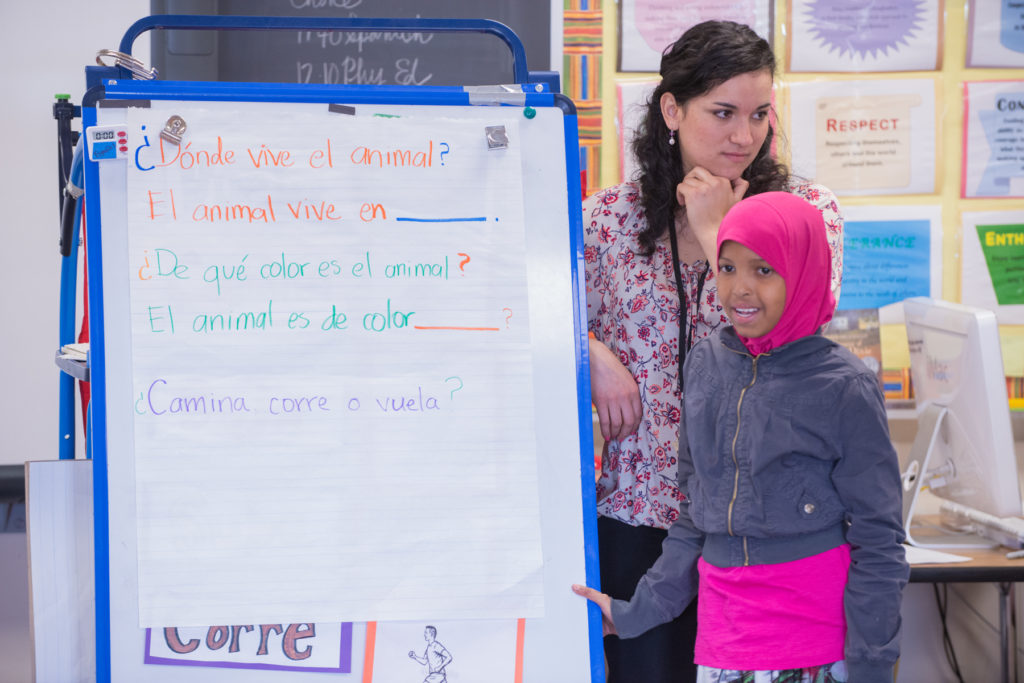
The number of students speaking English as a second language (ESL) is steadily increasing. These children come to the classroom with diverse cultural backgrounds and varying degrees of proficiency with English. We asked several educators, “What are your ideas for helping second language learners feel welcomed and supported in the classroom, especially during the early weeks of the year?
A: In addition to meeting the educational needs of second language learners, many teachers struggle to understand cultural differences, communicate with families, and help students and their families feel welcomed in school. Below are some general guidelines to help classroom teachers meet these challenges.
Recommended Reading: Cultural Differences and Social Skills Instruction: Understanding Ethnic and Gender Differences, Gwendolyn Catledge and Joanne Fellows Milburn, 1996.
Melissa Correa-Connolly is an academic counselor at Academy Middle School in Fitchburg, Massachusetts. She has taught grades 3-5, bilingual and special education. She leads workshops for K-8 teachers on teaching second language learners and is a Responsive Classroom certified consulting teacher.
A: The key to helping second language learners is to provide a supportive, nonthreatening, and language-rich environment. Language emerges naturally in such an environment. Here are a few ideas for welcoming these children into a new school.
Tara Allen is a fifth grade teacher at Bywood Elementary School in Upper Darby, Pennsylvania. She has been a classroom teacher for five years and is in the process of becoming a presenter for The Responsive Classroom approach.
A: As an ESL teacher, I always introduced a unit on “Our Families” early in the school year. It was a great way for all of us to get acquainted and for non-English speaking students to begin to learn English. This unit could be adapted for use in any primary classroom.
I began by sharing photographs of my family, along with magazine photos of diverse family groups. Using these photos, I introduced family vocabulary—mother, father, baby, brother, sister, grandmother, etc.—and we practiced using these words in various sentence forms. I then asked children to draw a portrait of their own family. For non-English speaking students, I demonstrated what I wanted them to do.
We displayed the finished drawings on a bulletin board, leaving space beside each one for a photo. I then sent home notes (translated into the family’s primary language if possible) asking families to send in family pictures or photocopies of them. For children who didn’t have photographs, I either made a home visit and took photos myself or sent the child home with a disposable camera.
These photos and drawings became the reference material for a wealth of language instruction, both oral and written. We used them to practice vocabulary, handwriting, and sentence writing. Students also made books about their families that were cherished both at school and at home. As children’s language development progressed, we began to share real family news: “My grandmother is sick” or “We have a new baby.” Giving second language learners the English words for the people they love the most is a powerful way to make connections early in the school year. It helps ESL students grow in language proficiency while everyone grows to know one another.
Recommended Reading: Conversations of Miguel and Maria: How Children Learn a Second Language, Linda Ventriglia, 1979
Bonnie Baer-Simahk is the early childhood coordinator for the Fitchburg, Massachusetts, public schools and a consulting teacher for Northeast Foundation for Children. She is a former kindergarten and ESL teacher, grades K–6.
A: Last year, the ESL teacher and I decided to cluster all of the kindergarten ESL students in my classroom. This allowed the ESL teacher to work with these children within their regular classroom, helping the students to feel less isolated and more connected to their classroom community.
Early in the year, Morning Meeting provided many opportunities for helping ESL students feel a sense of belonging while helping English-speaking students develop understanding and empathy for their non-English speaking classmates (see The Morning Meeting Book). For the daily greeting, we learned how to say hello and good morning in the ESL students’ languages. For sharing, the English-speaking students modeled how to do this and it wasn’t long before the ESL students began to sign up. Even if they couldn’t communicate fully with words, many participated successfully by holding up an item to share and responding to yes or no questions. During group activity and news and announcements, the ESL students became familiar with many common English words and phrases along with songs, chants, and raps.
Throughout the year, English-speaking students paired up with ESL students to help them learn to use areas or materials in the room. Family members of ESL students visited the classroom and taught us how to count, speak, or write in their language. Around Chinese New Year, one student’s mother taught us how to write 0–10 in Chinese. Children made red Chinese scrolls and used black paint to write their phone numbers in Chinese.
This year, the ESL teacher and I organized a summer orientation for ESL students and their families. This involved a guided tour of the school and classroom and an introduction to routines and materials. Families left with a glossary/pictionary of important words and phrases for the beginning of the school year. I’m looking forward to starting another year of this program; the benefits are tremendous for all the students.
Rick Ellis has been an early childhood/elementary school educator for over twenty-five years. He currently teaches kindergarten at the Dutch Neck School in West Windsor, New Jersey.